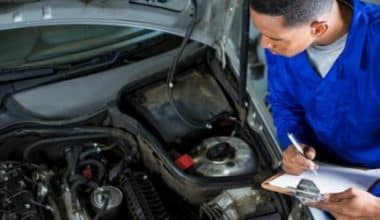By “full coverage,” we mean a package of car insurance policies that pays for the policyholder’s losses as well as those of the other drivers and passengers involved in an accident. Full coverage car insurance works by covering collision, comprehensive, and the minimum liability insurance that most states require. The best way to reduce your full coverage cost is to compare quotes from a minimum of three car insurance providers. This way, you can get the best deal.
How Does Full Coverage Car Insurance Work?
The term “full coverage” refers to policies that include not only the mandatory minimums but also additional protections such as medical payments and towing. If you have full coverage auto insurance, you will not have to worry about paying for repairs after an accident, theft, or natural disaster that causes damage to your vehicle.
When you purchase full coverage car insurance, you are covered for things like theft, vandalism, and damage. These policies cover your vehicle in the event of an accident, damage from a natural disaster or other unforeseeable event.
In most cases, collision and comprehensive coverage are not required by law and are therefore expensive. The biggest benefit, however, is that you will be protecting your vehicle, thereby reducing the likelihood of having to pay for expensive repairs. Even though no state mandates it, some lenders and lessees insist on collision and comprehensive coverage.
How Does Full Coverage Car Insurance Work?
If you have a policy with full coverage, it will pay for any damage that your vehicle causes to other vehicles as well as any injuries that you cause to other people. If you are at fault in an accident or if severe weather, theft, or other events damage your vehicle, your insurance will cover the costs of repairs. Uninsured motorist coverage and personal injury protection are two optional riders that could be added to the policy.
Why You Need Full Coverage
Complete auto insurance coverage will safeguard your vehicle if you cause an accident. Compared to a liability policy, this offers you greater coverage.
Some leasing and financing firms may demand it. Your car loan or lease agreement may stipulate that you carry full coverage car insurance. It is risky to count on the insurance of other drivers. When filing a claim through someone else’s policy, there is a greater chance that only a portion of the claim will be paid. It is also necessary to show who the “at-fault” driver is if you file through a different insurance company. This is not always easy to figure out and may vary from state to state.
When is it a Good Idea to get Full Coverage Auto Insurance?
Financing or leasing a car typically necessitates having full coverage car insurance. The bank or leasing company will want to see proof that your car is fully insured for the length of the loan or lease. If you do not already have this coverage, your lender may be able to provide it.
Furthermore, you may require full coverage if you:
- Own a pricey vehicle that may be expensive to repair.
- Get to work often in heavy traffic
- Not willing to or unable to pay for repairs
- Living in an area where there is a high risk of crime, bad weather, or other factors like a lot of animals or overgrown trees
- When you need to protect more valuable things with higher limits
What Is Full Coverage Car Insurance?
Full coverage car insurance covers all of the things that could go wrong with your car, the people inside it, and other cars and people in it if you get into an accident. While it is true that no car insurance policy can safeguard you against every eventuality, “full coverage” does cover you in the vast majority of situations.
If you get into an accident and damage another person’s vehicle, full coverage insurance will pay for that damage as well as the other person’s medical expenses.
How to Save Money on Full-Coverage Car Insurance
Your goal is to avoid overspending on your auto insurance, regardless of the options you select. These tips will help you find cheap full-coverage auto insurance and reduce your premium.
#1. Compare Prices
Get multiple quotes for auto insurance before making a final decision. To ensure that you are comparing costs, verify that each quote includes the same coverage and limit amounts. It is possible to save hundreds of dollars just by shopping around.
#2. Raise your Deductibles
Raising your deductible is one way to reduce your premiums and save money. Deductibles are the portion of an insurance payment that the policyholder is responsible for paying. Both collision and comprehensive policies offer deductibles of $500 and $1,000, respectively.
#3. Boost Your Credit Score
When determining premiums, many car insurers look at a customer’s credit history. A credit-based insurance score is used, which is only slightly different from a regular insurance score. To an insurance company, your credit score is a reliable indicator of your likelihood to file a claim. By strengthening your credit report in general, you can expect lower premiums for insurance that uses credit as a risk factor. However, insurance companies can not use credit history as a factor in every state.
#4. Utilize Discounts
Multiple-vehicle and multiple-policy discounts on auto insurance are fairly common. Discounts for things like paperless filing and setting up automatic EFT payments are also common. Discounts for safe drivers, good students, and vehicles with safety features are also possible.
What Does Full Coverage Insurance Cover?
When you have full coverage, your insurance provider will pay for any medical expenses and property damage your car causes. If you are at fault in an accident or if severe weather, theft, or other events damage your vehicle, your insurance will cover the costs of repairs. Personal injury protection and uninsured motorist coverage are additional options for the policy. Here is a rundown of the various sections that make up a typical comprehensive policy.
#1. Liability Car Insurance
Every state except New Hampshire and Virginia mandates that motorists carry liability insurance. If you are sued after a car accident, liability insurance will also pay for your defense expenses. These state mandates specify two types of liability coverage:
- Bodily Injury Liability: If someone else sustains an injury due to your negligence, bodily injury liability insurance will pay for their medical care.
- Property damage liability: If you crash into someone else’s property and cause damage, your property damage liability policy will pay for the repairs. This could be anything from a car to a mailbox to a fence to a set of garden gnomes to an entire structure.
#2. Collision Insurance
Regardless of who caused the accident, collision insurance will cover the cost of repairing any damage to your vehicle. What this means is that regardless of who caused the accident, your insurance company will pay to have your car repaired or replaced.
#3. Comprehensive Coverage
If something catastrophic happens to your car, like a tree limb falling on it, vandalism, or a baseball smashing through the windscreen, comprehensive insurance will help pay for the repairs.
Most of the time, you can not avoid these things. Since comprehensive claims tend to be much smaller than collision claims, comprehensive insurance tends to be much cheaper. Lowering your deductible is another way to save money on full coverage.
#4. Personal Injury Protection
If you are hurt in an accident, no matter who was at fault, your PIP insurance will cover the costs.
This means that if you are involved in an auto accident, PIP will pay for the medical expenses of you and your passengers. Personal Injury Protection (PIP) typically overlaps with existing health insurance policies and serves as a useful supplement to existing coverage. Twelve states mandate that drivers have PIP coverage. You can obtain optional medical payment coverage, also known as MedPay, in the remaining 38 states.
#5. Medical Payments Coverage
MedPay will cover the costs of medical care for you and your passengers in an accident, regardless of who was at fault. This may necessitate the use of an ambulance, surgical intervention, or imaging techniques.
#6. Uninsured or Underinsured Motorist Insurance
When a driver who does not have insurance hits you or your car and does not have insurance, you can get uninsured motorist coverage. When the at-fault driver does not have adequate insurance, your underinsured motorist coverage kicks in. Generally, you would claim from the insurance company of the other driver if they had insurance. If they do not have insurance, your uninsured motorist policy will kick in.
- Uninsured motorist property damage (UMPD) coverage: If the person who hit you does not have auto insurance, uninsured motorist property damage (UMPD) coverage will help pay for the damages to your vehicle.
- Uninsured motorist bodily injury coverage (UMBI): If you suffer injuries in a car accident that was the fault of someone without insurance, UMBI will assist in paying your medical bills.
What is Excluded from Full Coverage?
Although the term “full coverage” implies that any risks are covered, there are situations in which full coverage auto insurance will not pay out.
- Damage with intent
- Should you use your vehicle for work-related purposes (commercial auto insurance is typically required),
- Racing or speed competitions
- Mechanical failures and servicing
- Theft of your personal belongings from your vehicle (covered by homeowners or renters insurance)
- Accessories that are not permanently attached to your car
- Normal wear and tear on the vehicle
How Much Is Full Coverage Insurance a Month?
Full coverage car insurance policies cost about $2,067 annually on average in the United States. Full coverage car insurance rates can vary widely from one insurance provider to the next. Finding affordable and comprehensive auto insurance requires shopping around and comparing quotes from multiple providers.
Full coverage costs about $168 a month, while minimum coverage costs about $52 a month. Although not all drivers can use them, Geico, Erie, and USAA provide some of the most affordable full-coverage auto insurance.
Your situation may seem similar to someone else’s, but your premium will be different due to individual rating factors. Still, finding out how much car insurance costs on average might help you make sure you are not paying too much for this important financial protection.
How to Save On Full Coverage Car Insurance
- Compare prices. If you are looking for affordable full coverage car insurance, it is crucial to compare quotes. Find the most affordable rate by comparing the charges of at least three different providers.
- Look for discounts. Discounts on auto insurance can be had for just about anything these days, including good grades and brand-new vehicles. You can save the most money possible by calling your agent and verifying the current deals.
- Raise your deductible, if possible. An effective way to reduce your auto insurance costs is to increase the deductible—the amount you have to pay out of pocket before the insurance company makes a claim. Your overall policy cost will go down if you do this, but the amount you save will depend on the insurance company.
- Avoid traffic violations. Car insurance premiums can skyrocket after just one infraction for things like speeding, being at fault in an accident, or being convicted of a DUI. Since moving infraction tickets can remain on your record for three to five years, you should avoid receiving them if you want the best rates.
- Improve your credit. Your credit score affects your auto insurance premium, even though it is not always simple to establish. After looking into how much car insurance costs on average, we found that some drivers’ rates can go up more because of bad credit than because they got a DUI recently. Nevertheless, there are some exceptions: Insurers are not permitted to consider credit history when setting rates in the states of California, Hawaii, and Massachusetts.
Is It Better to Have Full Coverage or Liability?
Usually, getting full coverage car insurance is a good idea. In the event of an accident in which you are found at fault, your liability insurance will not cover repairs to your vehicle. Furthermore, losses resulting from vandalism, theft, or natural disasters will not be covered by liability insurance.
What Are the Disadvantages of Having Full Coverage Car Insurance?
One drawback of full coverage insurance is that it typically costs more than liability-only policies. Additionally, it might make you think that the policy covers everything. However, for more comprehensive protection, you may wish to consider purchasing additional insurance policies, such as GAP or PIP.
What Is Full Coverage Good For?
Full coverage insurance covers damage to your vehicle resulting from a storm, an accident in which you were at fault, colliding with an animal, or vandalism. Full coverage insurance will reimburse you for the market value of your vehicle in the event of theft, making it possible to buy a new vehicle.
What Is an Example of Full Coverage Insurance?
The term “full coverage” is used to describe a set of insurance policies that include not only liability insurance but also other policies like collision insurance, comprehensive insurance, medical payments coverage, and personal injury protection.
What Is the Difference Between Full Coverage and Collision?
Car accidents are the most common reason for a driver to make use of collision insurance. Collision insurance is different from comprehensive insurance. It is useful for covering things like theft, hail, and falling trees that do not happen while driving.
How Do I Know if I Have Full Coverage?
Full coverage car insurance covers three main areas: liability, comprehensive, and collision. With these three types of insurance, you will not have to worry about the cost of repairs after a car accident or damage from something like vandalism or natural disasters.
Why Is Full Coverage Insurance So High?
A full coverage policy costs twice as much as one with only minimum liability coverage. Comprehensive and collision insurance are usually part of full coverage. These policies cover the cost of replacing or repairing your damaged vehicle.
When Should You Not Get Full Coverage?
Traditionally, it is recommended that drivers stop carrying collision and comprehensive coverage once their vehicles exceeds six years. You should also drop full coverage when the deductible on your full coverage insurance is more than the value of your car.
When Can You Stop Having Full Coverage Car Insurance?
When you have finished paying off your car loan, you will be able to stop paying for collision and comprehensive insurance for your vehicle. On the other hand, if your vehicle has a higher market value, you should think about whether or not to continue carrying these coverages.
Is At-Fault Car Insurance Included in Full Coverage?
In the event of an accident in which you are found to be at fault, full coverage auto insurance will pay for the repairs to your vehicle. However, in the majority of jurisdictions, this insurance does not cover injuries to you or your passengers. Up to the policy maximum, the at-fault driver’s insurance company pays bodily injury claims in “no-fault” states.
What is the difference between Full Coverage and Comprehensive Car Insurance?
Full coverage includes collision and comprehensive coverage for your vehicle. Comprehensive insurance protects against a wide variety of perils outside of collisions, including things like hail, fire, and flooding. It also includes theft and damage to property. Most of the time, “full coverage” means that a policy includes the minimum insurance required by the state as well as collision and comprehensive coverage.
Conclusion
Although full coverage car insurance does not refer to a particular kind of policy, it has come to mean a policy that covers comprehensive, collision, and liability risks. If your vehicle is new or expensive, or if you simply want to protect yourself from having to pay a large sum of money to have repairs made after an accident, full coverage is the way to go. Additionally, if you have a car loan or lease, it is typically a requirement. Even cheap full coverage car insurance offers better protection than state-mandated minimum coverage.
- Liability vs Full Coverage Car Insurance 2023: Which Is Better?
- THE MAIN TYPES OF CAR INSURANCE COVERAGES: 2023 Update
- BEST CAR INSURANCE YOUNG DRIVERS FOR 2023
- COLLISION INSURANCE: What Is It & What Does It Cover?
- LOSS ASSESSMENT COVERAGE: How Does It Work?






